The continuously evolving shape of a chair has seen it mould to many fashions and interior design styles over centuries, from baroque grandeur to the natural simplicity of the arts and crafts movement. These popular pieces of antique furniture often have a long history of practical use, especially those belonging to Victorian dining sets or mid-century modern homes, leaving them vulnerable to accidental damage and joint deterioration.
 Above: a selection of chair designs from different eras
Above: a selection of chair designs from different eras
This article will look into the history of chair design, including typical styles from 18th century and 19th century interiors. We will also explore the ways antique chairs can be professionally cared for and restored with historically accurate techniques.
 Above: chairs as seen in paintings from different eras including a portrait of Prince de Bénévent from 1808, a portrait of Maria Luisa of Parma from 1765 and a portrait by Moroni from 1553
Above: chairs as seen in paintings from different eras including a portrait of Prince de Bénévent from 1808, a portrait of Maria Luisa of Parma from 1765 and a portrait by Moroni from 1553
Ancient chairs
Chairs can be dated as far back as the Archaic period in ancient Egypt, around 3100 BC. As well as having practical use, they can be seen as symbols of power with decorative features to match the high status of their owner. These early Egyptian chairs may have featured gold leaf, ivory, elaborate carving and leather seats. In ancient Greece, examples of chairs can be seen on the frieze of the Parthenon, where Zeus sits upon a heavily ornamental seat.
 Above: examples of chairs from ancient Egypt including a mural dated 1944 BC and Hatnefer’s Chair dated 1492–1473 BC
Above: examples of chairs from ancient Egypt including a mural dated 1944 BC and Hatnefer’s Chair dated 1492–1473 BC
In both Egypt and Greece, examples exist where chair legs end in animal claws – a classical style that would later be drawn upon time and time again in European furniture design.
 Above: examples of chairs in Roman fresco art dated to 50-40 BC
Above: examples of chairs in Roman fresco art dated to 50-40 BC
Medieval chairs
Medieval chairs were reserved for royalty and the seats of those of high command in Christianity, the word chair actually stems from the Latin cathedra – a term that is still used to refer to the seat of power within a cathedral, often a raised throne for a bishop. This was then translated into Old French as chaiere and Old English as chaere. Before the production of individual chairs affordable to the general population, it would have been less costly and more practical to use benches or simple wooden stools.
 Above: examples of chairs from the medieval period including a sculpture of a king from 1230, a painting of a seated madonna and child from 1420 and a drawing of St John the Evangelist from 1480
Above: examples of chairs from the medieval period including a sculpture of a king from 1230, a painting of a seated madonna and child from 1420 and a drawing of St John the Evangelist from 1480
Renaissance chairs
It was not until the Renaissance period that chairs were more commonplace in homes besides those of the very wealthy. From this period onwards the size, shape and overall design of chairs changed rapidly to keep up with changing tastes in interior design and the fashion of its user. For example, wider chairs were created to encompass the wide skirts of noble women and then downsized again once this fashion ended.
 Above: examples of chairs in renaissance portraiture, a 16th century side chair and armchair
Above: examples of chairs in renaissance portraiture, a 16th century side chair and armchair
There is a continuation in the renaissance and late medieval period of the sella curulis design, also known as a curule chair. This was an early form of folding chair used by leaders and officials in ancient Rome, this seat became symbolic of power and continued to be used by high ranking clergy under Christian rule. Also known as a faldistorium or faldstool, they were often used by bishops when they were not occupying their cathedra throne.
 Above: a selection of curule chairs from the renaissance era
Above: a selection of curule chairs from the renaissance era
Tudor furniture is often a solid form with some carved decorations, such as a Gothic linenfold. Unlike smooth and delicate continental features of the continental renaissance, Elizabethan and Jacobean furniture tend to display more of a coarse and handcrafted appearance when it comes to decoration. The ornamental elements are predominantly gothic, but can also feature classical and heraldic details. The most common type of wood in early British chair design is walnut or oak, due to local cultivation. Whilst oak is naturally either a light beige or brown, it was often stained for a darker appearance.
 Above: an example of a late renaissance living space recreated in the Minneapolis Institute of Arts, the oak panels date to 1600
Above: an example of a late renaissance living space recreated in the Minneapolis Institute of Arts, the oak panels date to 1600
From the late 17th century onwards, inspiration in British chair design is much more aligned with European fashion, especially a Dutch influence from William of Orange in the 1680s. The Dutch style was itself influenced by the French court of Louis XIV and the many French furniture makers who had fled in exile in 1685 – this included interior designer Daniel Marot who had a defining influence of the era.
 Above: a selection of early 17th century chairs, including a armchairs, side chair and a folding chair
Above: a selection of early 17th century chairs, including a armchairs, side chair and a folding chair
17th century chairs
Unlike the solid and functional chair designs of the Tudor period, William & Mary furniture has a focus on a unified decorative appearance, with smooth and scrolling features, woodturning techniques and long backs. Some decorative elements appear curling, such as elegantly curved legs. Upholstery is more commonplace, though sometimes just on the seat of a chair rather than the back, which remains solid or decorative carved wood. Caned seats and backs can also be found on William and Mary style chairs.
 Above: a selection of chair designs from the 17th century
Above: a selection of chair designs from the 17th century
18th century chairs
In the Queen Anne period, cabriole legs (a bending line with one upper and lower curve) were developed as an evermore popular feature. Flat vase-shaped backs are typical of the Queen Anne style, as are wide upholstered seats. There are also more C scrolls and S scrolls in the overall decoration as well as a simple scallop or shell carving in keeping with the baroque era as it moves further towards the rococo.
 Above: a selection of 18th century chairs including Queen Anne side chairs and Chippendale designs
Above: a selection of 18th century chairs including Queen Anne side chairs and Chippendale designs
Thomas Chippendale published his book entitled ‘The Gentleman and Cabinet-Maker’s Director’ in 1753 and this was culturally significant not only in British design but also in Europe and North America. Mahogany is often the wood of choice for Chippendale furniture, but less costly timber and materials may have been used over time including maple, walnut and cherry. The ornate style of Chippendale can still be found in reproductions up to the modern day. You can learn more about Chippendale styles here.
 Above: a selection of chair designs by Thomas Chippendale
Above: a selection of chair designs by Thomas Chippendale
Regency chairs
During the Regency period, neoclassicism dominated interiors. More constrained than the rococo period that preceded it, chair designs were inspired by an ever-increasing interest in archaeological sites such as Pompeii. In some cases, ancient Greek, Roman, or Egyptian seats were reproduced as a pure copy or drew strong inspiration from an original artefact.
 Above: a selection of Regency chair designs with neoclassical features
Above: a selection of Regency chair designs with neoclassical features
Victorian and Edwardian chairs
The 19th century saw an evermore accessible market for chairs due to the industrial revolution. However, a full set of dining chairs – especially those with decorative elements – could still be seen as a status symbol for the growing middle class in society. Many styles in the 19th century were inspired by the centuries prior, including gothic revival and the constant reproduction of Chippendale designs. Due to this, Victorian furniture may seem older than it is, but a close look at the joinery and craftsmanship may point to the correct era. Signs of machine cut lines or effects which may have only been made possible by industrial techniques point to the Victorian or Edwardian eras.
 Above: a selection of mid to late 19th century chairs that echo designs of the past
Above: a selection of mid to late 19th century chairs that echo designs of the past
Opposing the industrial influence, the arts and crafts movement sought to create a modern interior that used traditional timber and techniques. The central features of arts and crafts furniture include the use of nature, such as oak leaves or flora. However, they often value functionality over an abundance of decoration and aesthetic choices. Arts and crafts furniture may also show exposed pins and joinery and use local timber. You may find that these pieces come under a typical farmhouse or country style, displaying great technique in construction whilst not being overly extravagant or expensive to their original market.
 Above: a selection of Victorian photographs featuring everyday chairs
Above: a selection of Victorian photographs featuring everyday chairs
20th century chairs
Early 20th century furniture from Scandinavia was a defining influence, this saw a pull towards minimalism and used the principles of the Bauhaus movement. This was compelled by the world wars, which saw even more need for well-crafted functionality and manufacturing over purely aesthetic furniture for a modern home. Affordable furniture was also important for the booming consumer market which needed to cater for all aspects of society.
 Above: a selection of 20th century chair designs
Above: a selection of 20th century chair designs
Genuine wooden designs from this period are most often made from solid teak, rosewood or walnut. Higher-end chairs may have been cut from one piece or have a streamlined, flowing design, whilst others are simple but have hints of free-flowing curves in a wishbone shape or rounded edges. By contrast, some shapes have more of a futuristic look and use angles to define a strong aesthetic. Famous furniture influenced by or originating from this period includes tulip chairs and egg chairs.
 Above: innovative post-war chair designs became available to a mass market due to their functionality and affordability
Above: innovative post-war chair designs became available to a mass market due to their functionality and affordability
Professional chair restoration
Our furniture experts regularly work on chairs following accidental damage or major disasters, such as floods and fires. The most common reason for restoration is loose or broken joins, these can be professionally re-adhered and stabilised. All of the techniques used in our furniture studio strive to be as historically accurate as possible, using traditional materials and sourced timber to allow for the highest quality and integrity of the item following restoration. You can find out more about traditional repairs here.
 Above: a water damaged chair before and after restoration in our studio
Above: a water damaged chair before and after restoration in our studio
Joints can become loose or damaged due to changes in temperature, warping, infestations of woodworm, strain from incorrect or constant use, the disintegration of glue or metal, or faults in the original craftsmanship. A slightly loose structure may seem manageable and no more than a nuisance, but if handled, stored or transported inappropriately, can cause further damage and risk severe breakage and a more costly repair. Restoration should be considered before the joins split or break completely.
 Above: some of the traditional tools and materials used in our studio
Above: some of the traditional tools and materials used in our studio
Loose mitre joints in chairs can be restored by our experienced team who are able to sensitively take apart and reconstruct any number of historic chair designs to enable a stable result. All substances used during restoration are historically sensitive, such as bone hide glue and appropriately sized metal pins to replace deteriorated and rusted originals. Rush seats and caning can also be professionally restored using traditional craftsmanship and materials.
 Above: a cane seat before and after restoration in our studio
Above: a cane seat before and after restoration in our studio
Chairs with gilt surfaces can become scratched over time with abrasions leaving gesso and wood vulnerable to further damage. Our expert gilding conservators can restore gold leaf decoration to a level that suits both the object and your own aesthetic requirements. You can learn more about gold leaf care here.
 Above: a chair with gold leaf, part way through restoration
Above: a chair with gold leaf, part way through restoration
Water staining can be removed or improved in most cases, whilst water-damaged veneers, legs and arms can be professionally cleaned and – where needed – replaced with era-appropriate timber. All aspects can be finished with waxing or french polishing depending on the correct appearance, you can find out more about traditional furniture finishes here.
 Above: collections and sets of chairs can all be restored at the same time to ensure they are all well-preserved and protected to the same standard
Above: collections and sets of chairs can all be restored at the same time to ensure they are all well-preserved and protected to the same standard
How can we help?
If you have a chair that requires care or restoration, please speak to our helpful team who will be able to assist you with any era of design from medieval to mid-century modern.
Please email us via [email protected] or call 0207 112 7576

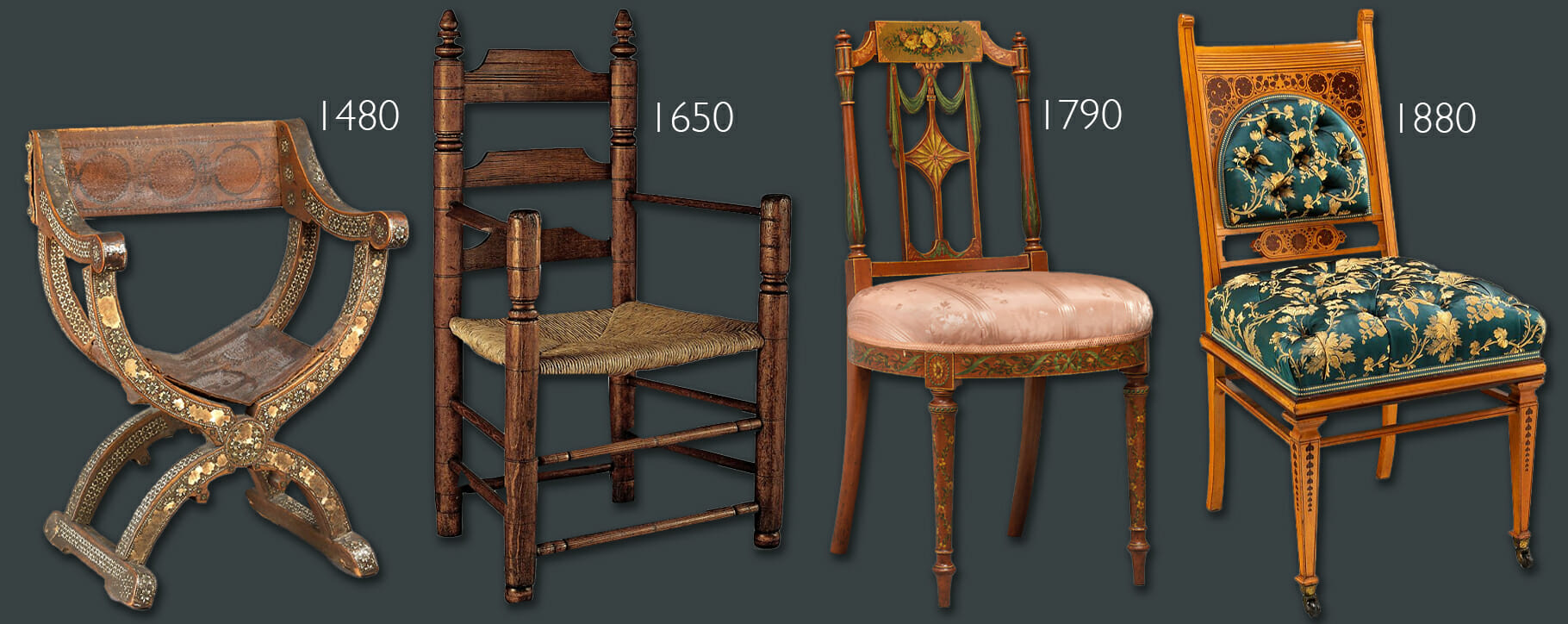 Above: a selection of chair designs from different eras
Above: a selection of chair designs from different eras 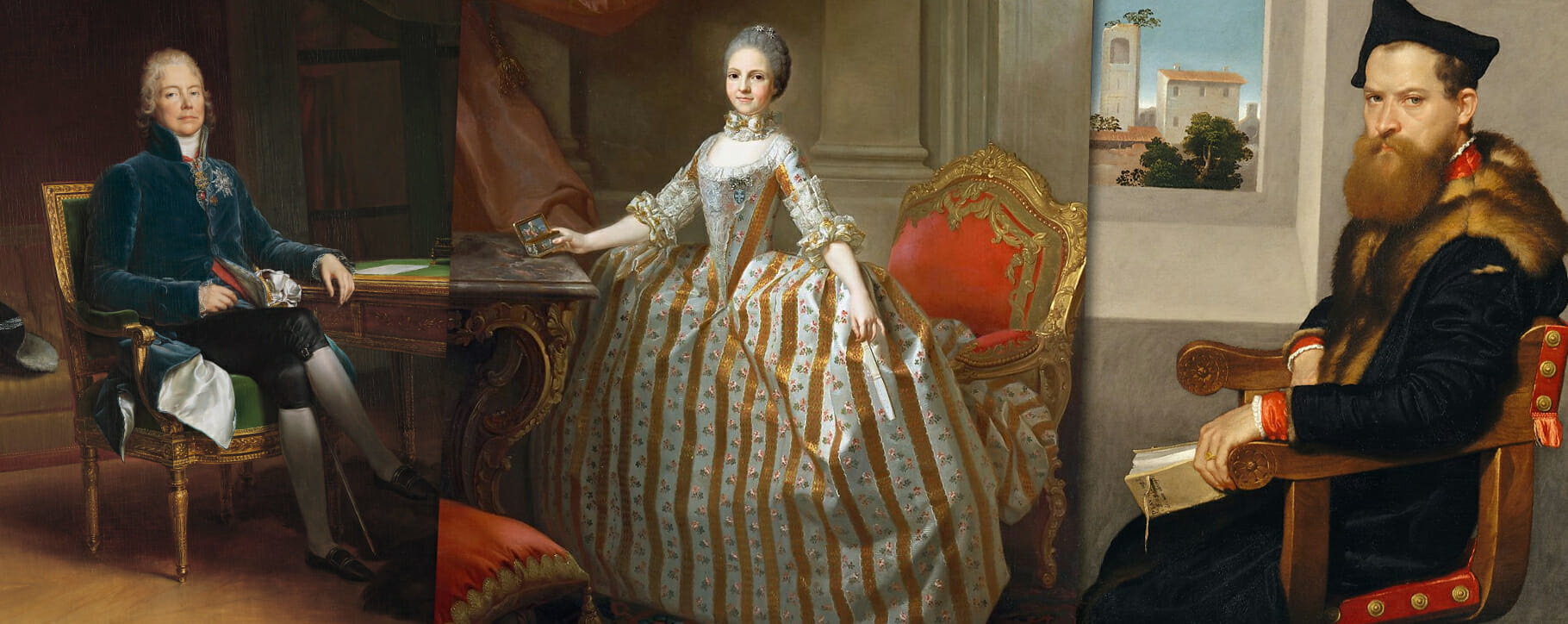 Above: chairs as seen in paintings from different eras including a portrait of Prince de Bénévent from 1808, a portrait of Maria Luisa of Parma from 1765 and a portrait by Moroni from 1553
Above: chairs as seen in paintings from different eras including a portrait of Prince de Bénévent from 1808, a portrait of Maria Luisa of Parma from 1765 and a portrait by Moroni from 1553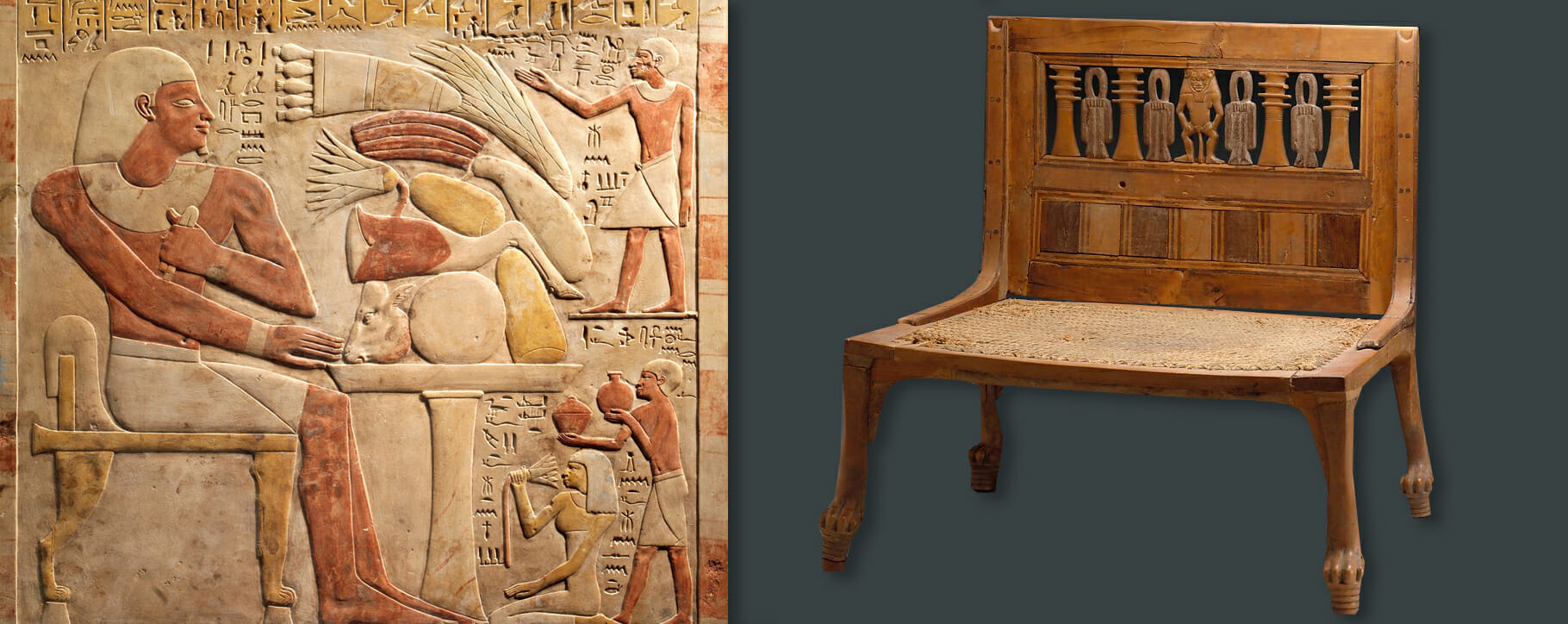 Above: examples of chairs from ancient Egypt including a mural dated 1944 BC and Hatnefer’s Chair dated 1492–1473 BC
Above: examples of chairs from ancient Egypt including a mural dated 1944 BC and Hatnefer’s Chair dated 1492–1473 BC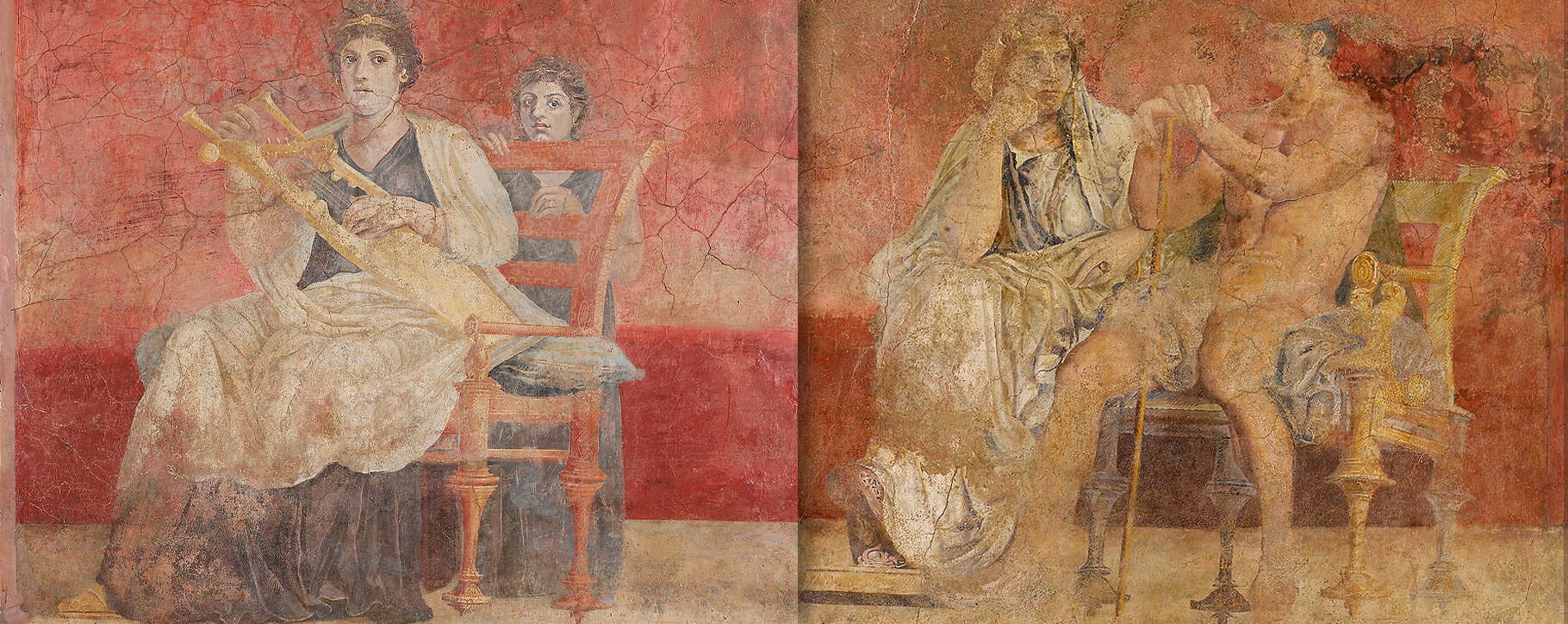 Above: examples of chairs in Roman fresco art dated to 50-40 BC
Above: examples of chairs in Roman fresco art dated to 50-40 BC Above: examples of chairs from the medieval period including a sculpture of a king from 1230, a painting of a seated madonna and child from 1420 and a drawing of St John the Evangelist from 1480
Above: examples of chairs from the medieval period including a sculpture of a king from 1230, a painting of a seated madonna and child from 1420 and a drawing of St John the Evangelist from 1480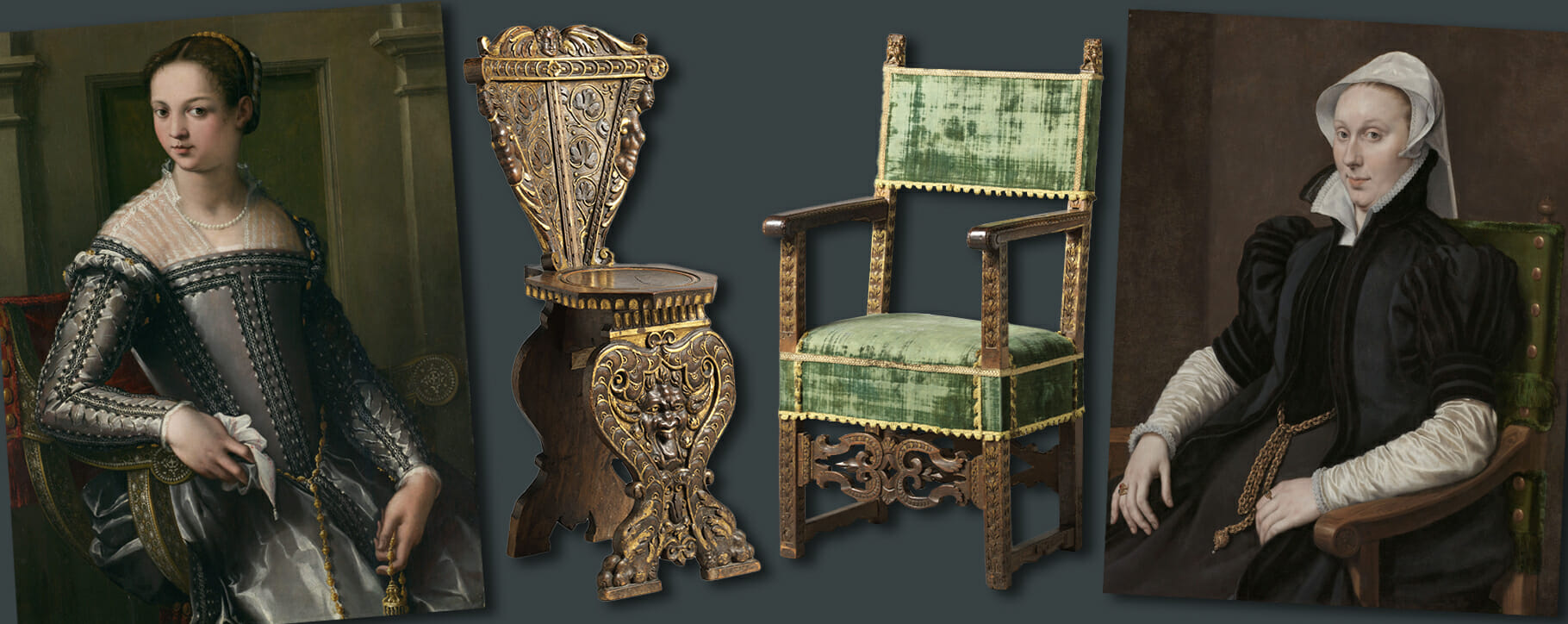 Above: examples of chairs in renaissance portraiture, a 16th century side chair and armchair
Above: examples of chairs in renaissance portraiture, a 16th century side chair and armchair  Above: a selection of curule chairs from the renaissance era
Above: a selection of curule chairs from the renaissance era Above: an example of a late renaissance living space recreated in the Minneapolis Institute of Arts, the oak panels date to 1600
Above: an example of a late renaissance living space recreated in the Minneapolis Institute of Arts, the oak panels date to 1600 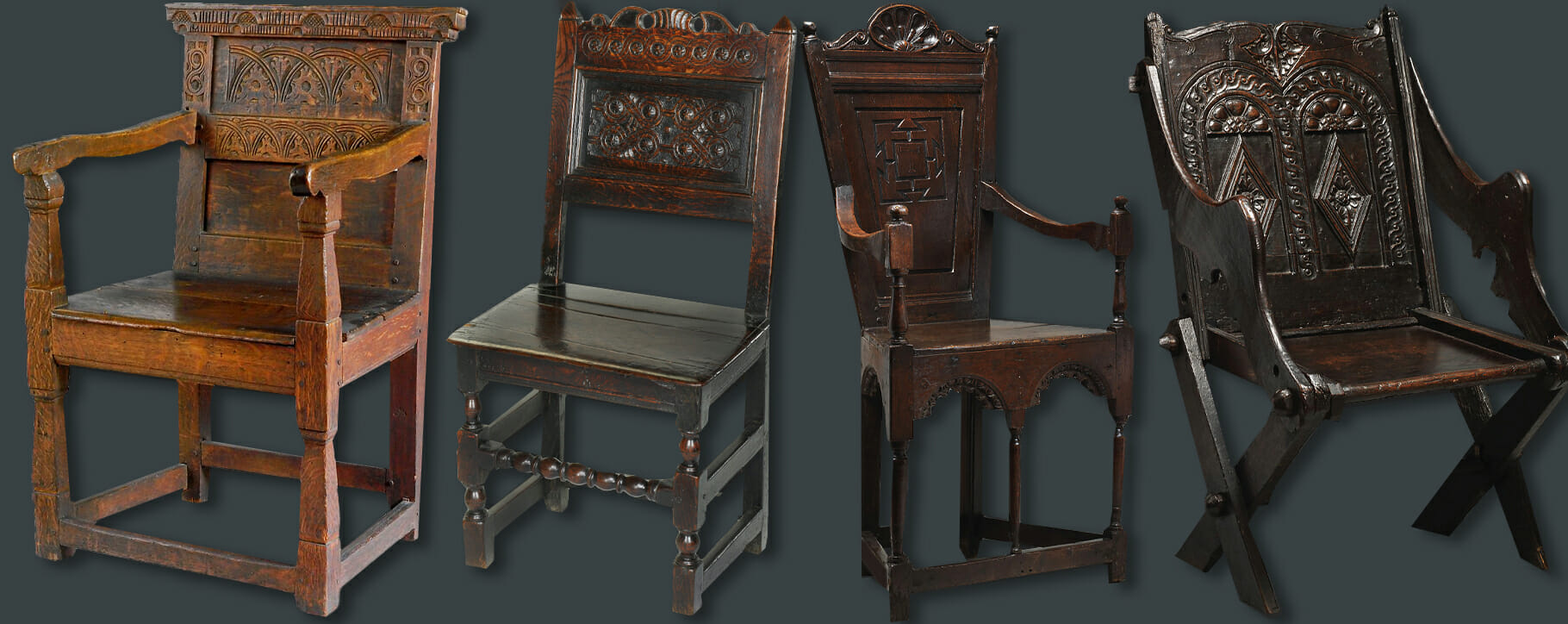 Above: a selection of early 17th century chairs, including a armchairs, side chair and a folding chair
Above: a selection of early 17th century chairs, including a armchairs, side chair and a folding chair 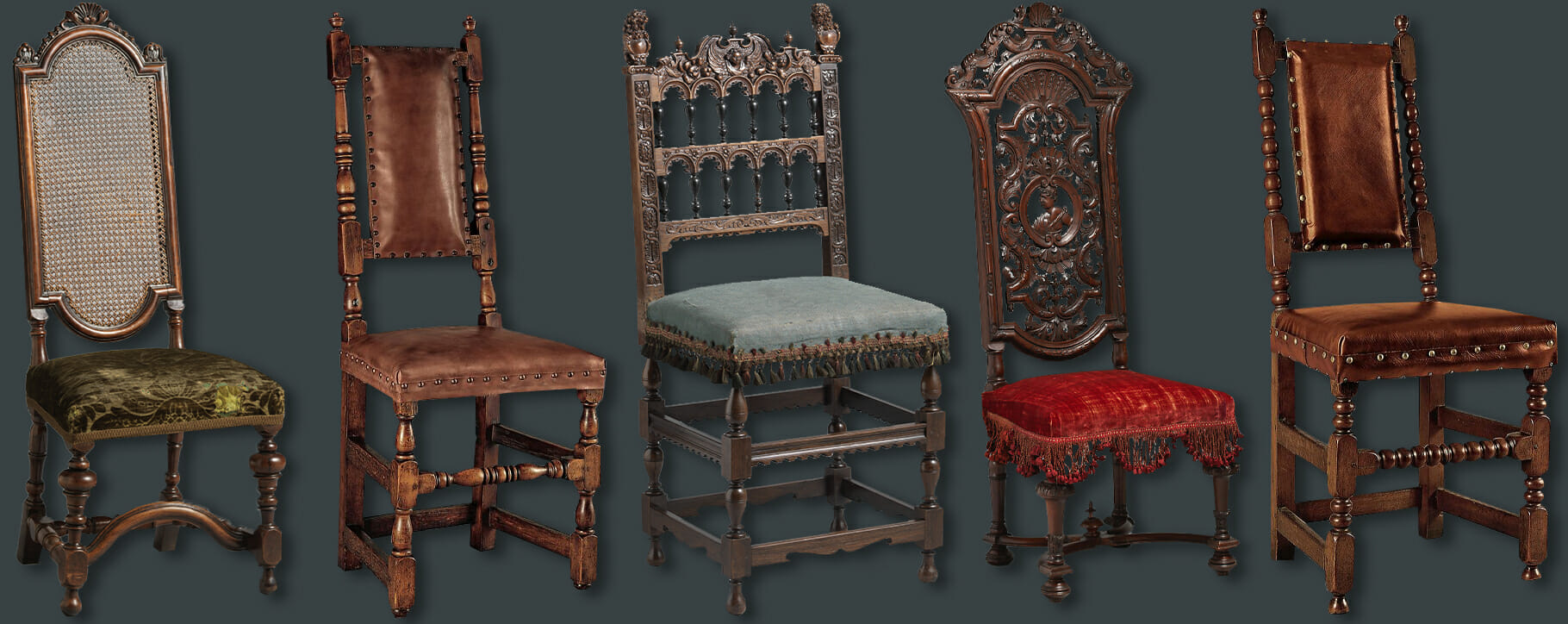 Above: a selection of chair designs from the 17th century
Above: a selection of chair designs from the 17th century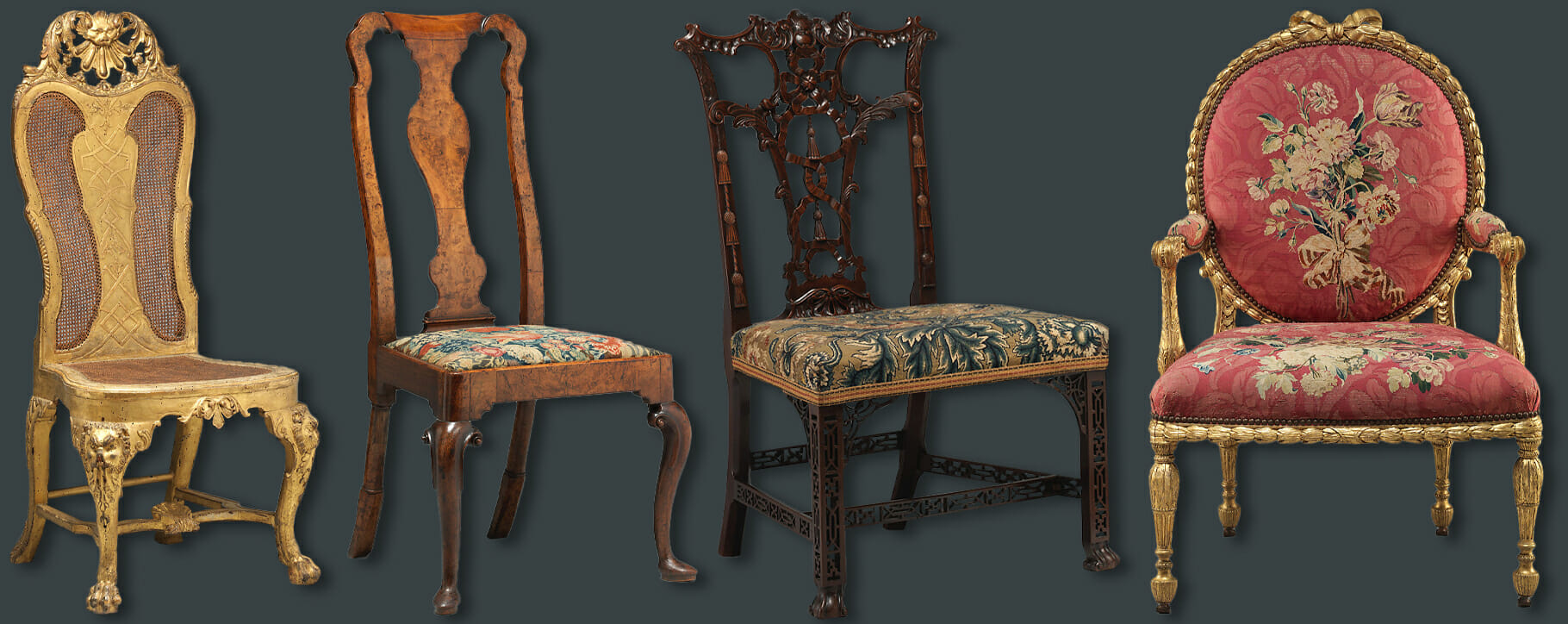 Above: a selection of 18th century chairs including Queen Anne side chairs and Chippendale designs
Above: a selection of 18th century chairs including Queen Anne side chairs and Chippendale designs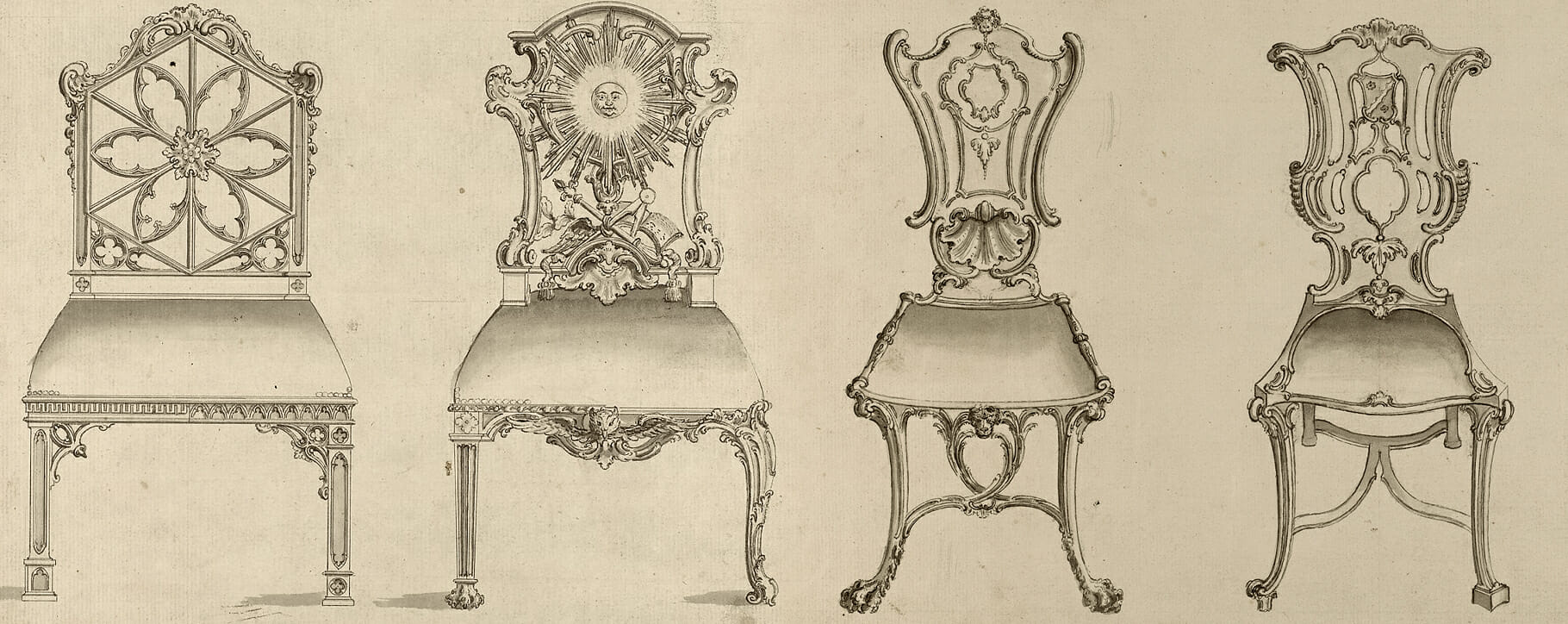 Above: a selection of chair designs by Thomas Chippendale
Above: a selection of chair designs by Thomas Chippendale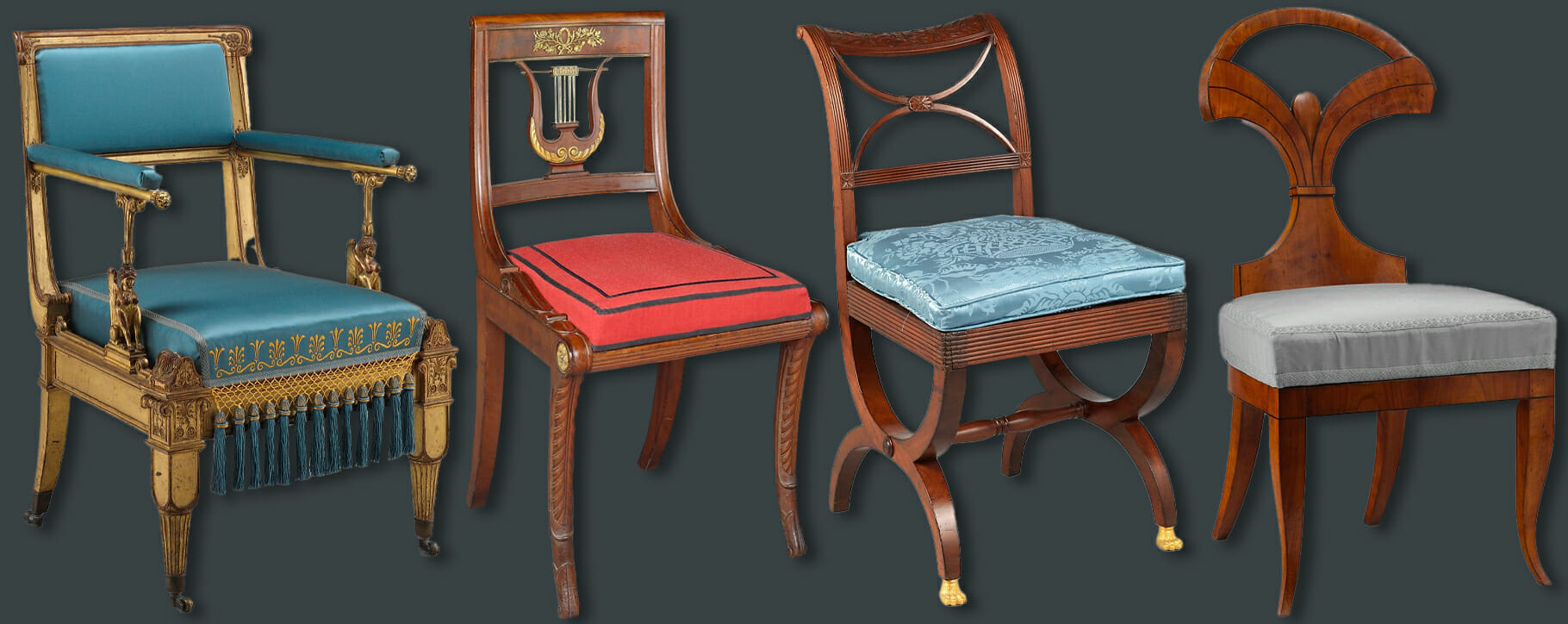 Above: a selection of Regency chair designs with neoclassical features
Above: a selection of Regency chair designs with neoclassical features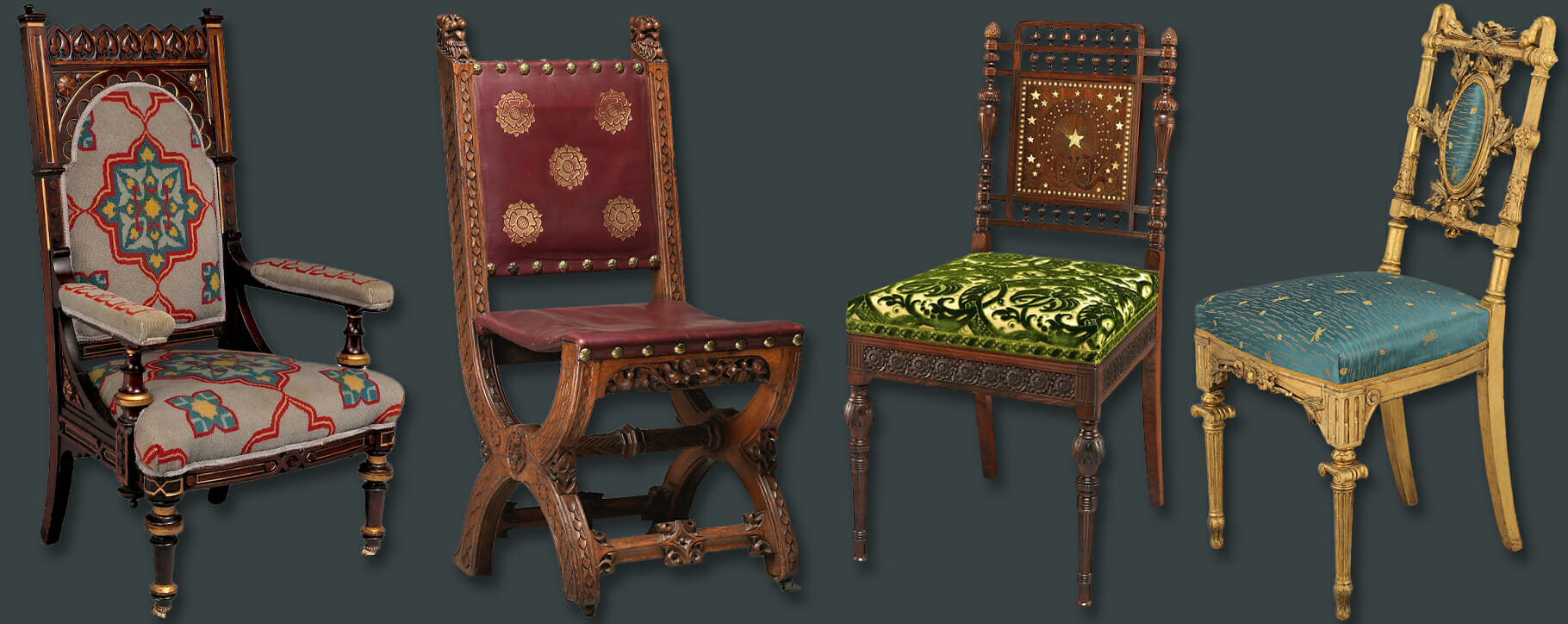 Above: a selection of mid to late 19th century chairs that echo designs of the past
Above: a selection of mid to late 19th century chairs that echo designs of the past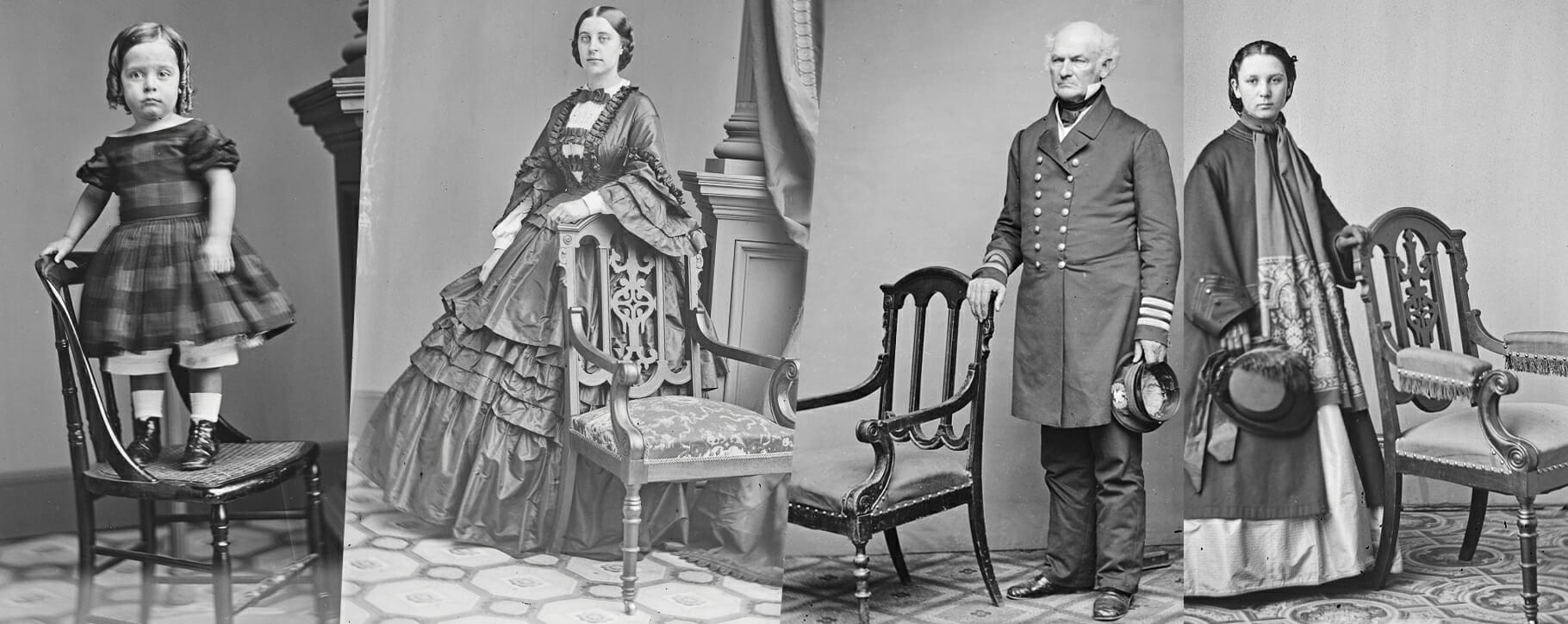 Above: a selection of Victorian photographs featuring everyday chairs
Above: a selection of Victorian photographs featuring everyday chairs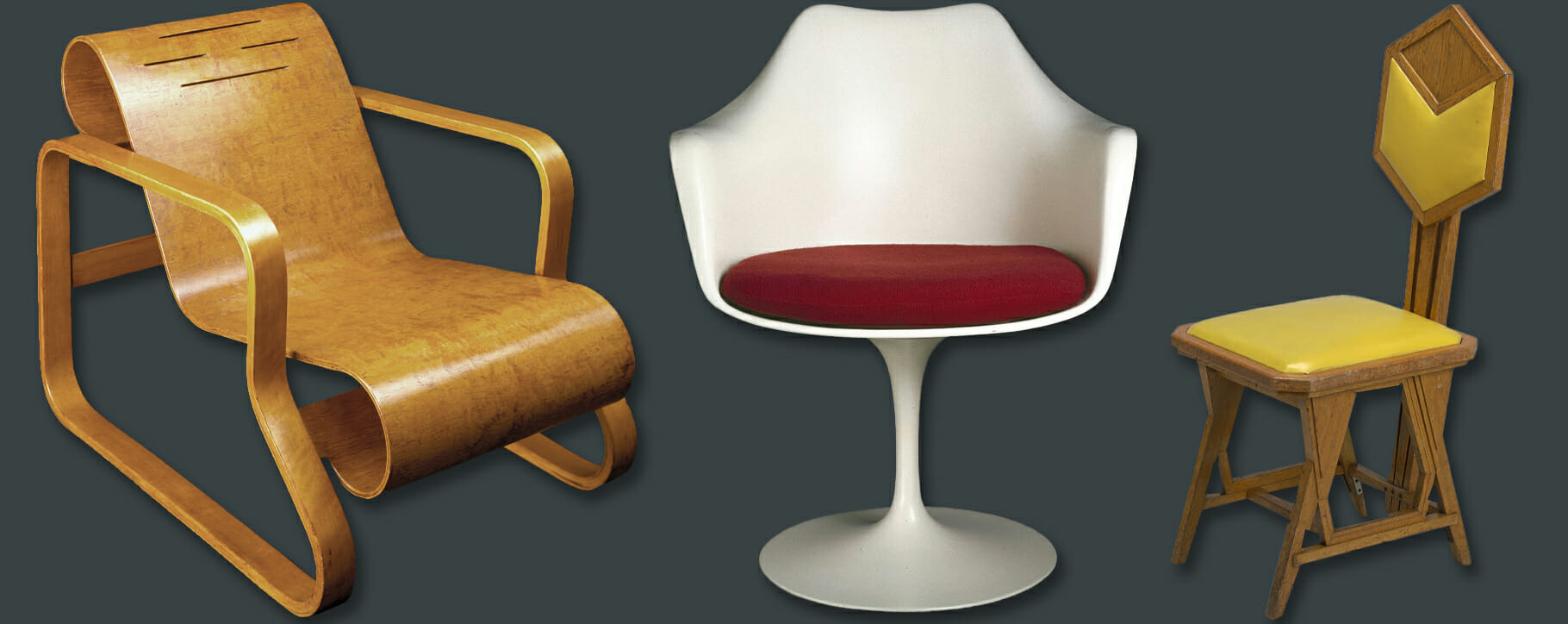 Above: a selection of 20th century chair designs
Above: a selection of 20th century chair designs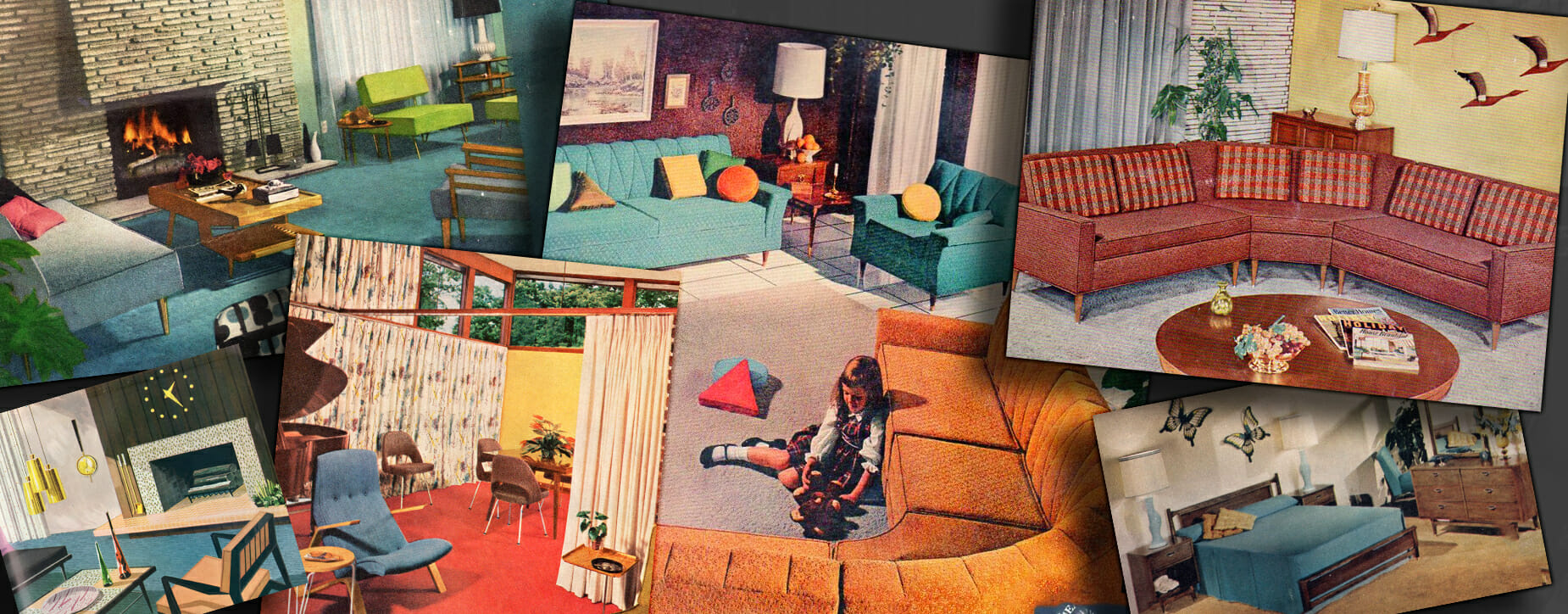 Above: innovative post-war chair designs became available to a mass market due to their functionality and affordability
Above: innovative post-war chair designs became available to a mass market due to their functionality and affordability 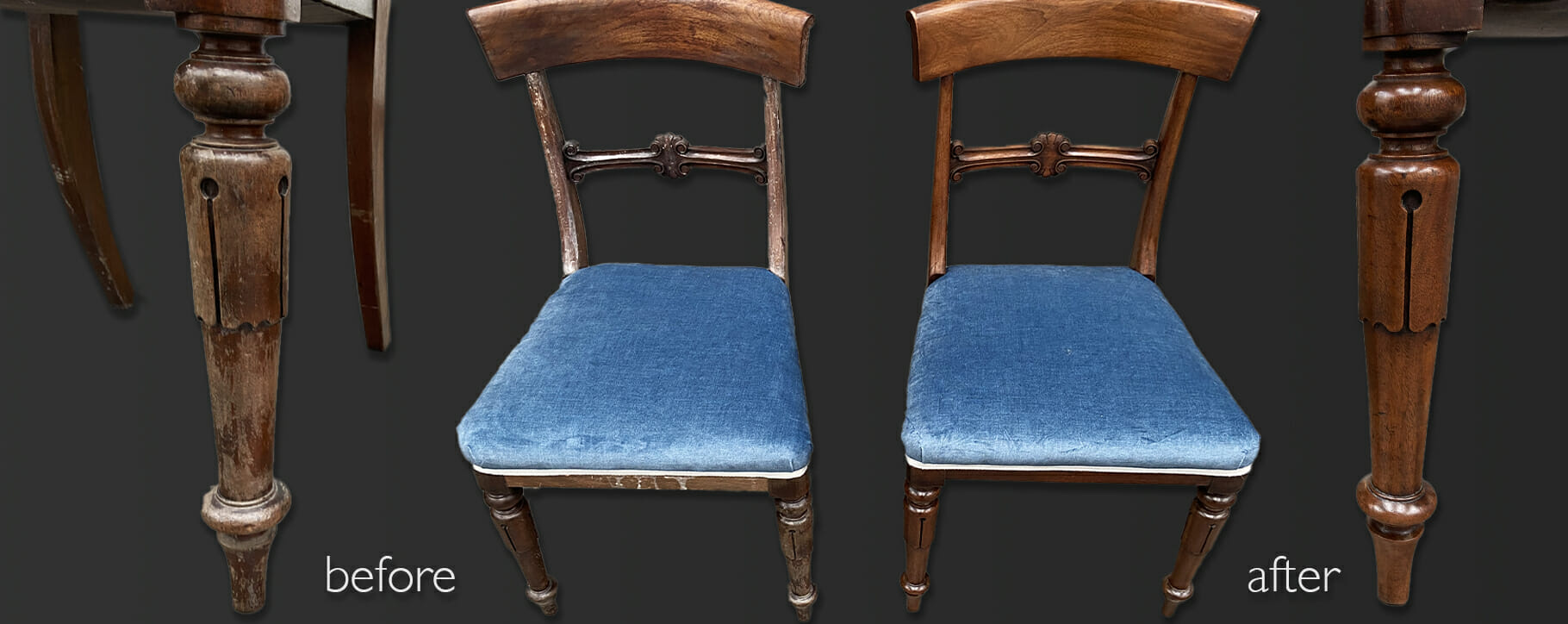 Above: a water damaged chair before and after restoration in our studio
Above: a water damaged chair before and after restoration in our studio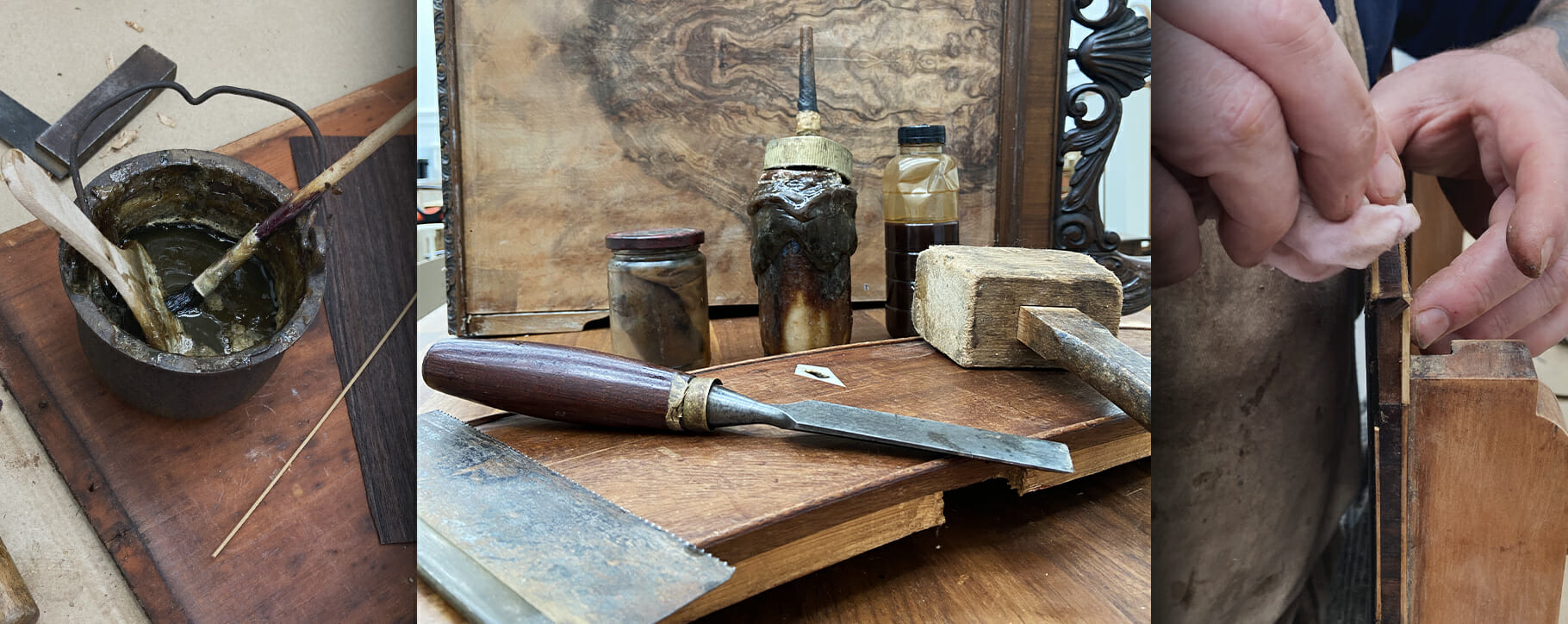 Above: some of the traditional tools and materials used in our studio
Above: some of the traditional tools and materials used in our studio Above: a cane seat before and after restoration in our studio
Above: a cane seat before and after restoration in our studio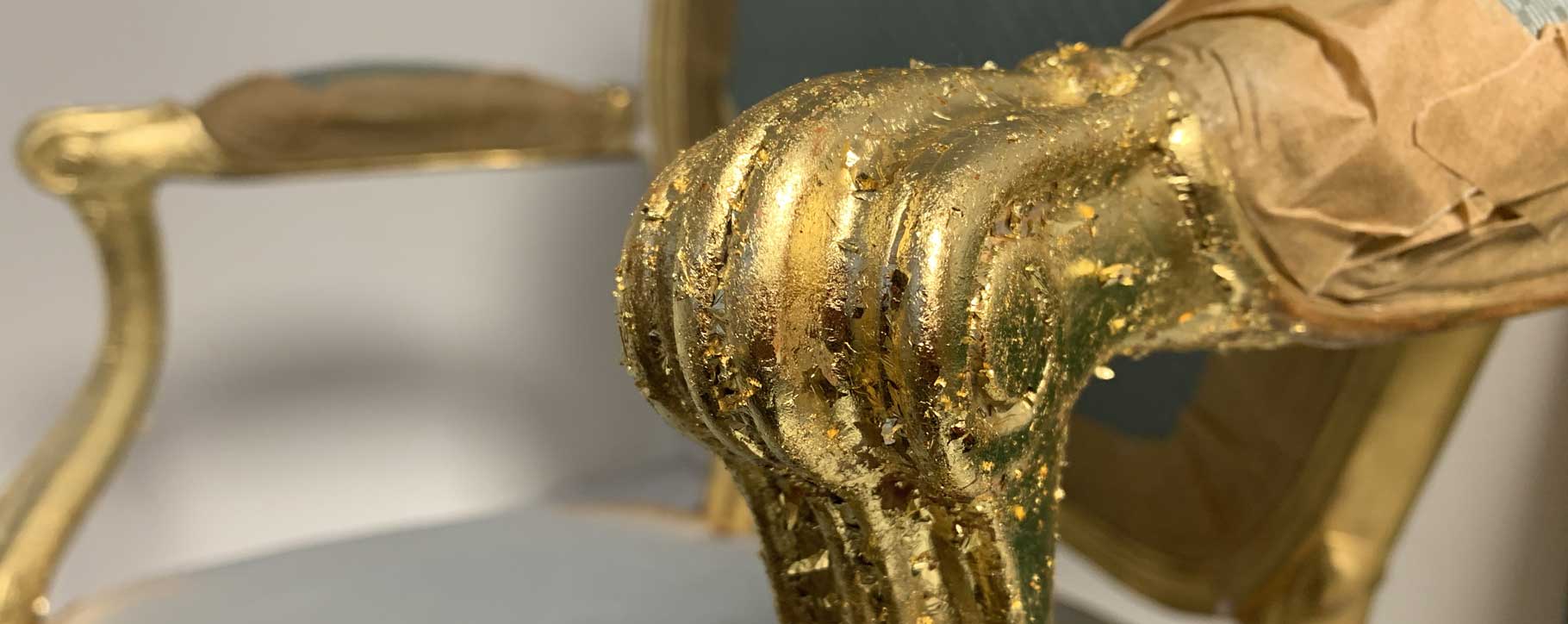 Above: a chair with gold leaf, part way through restoration
Above: a chair with gold leaf, part way through restoration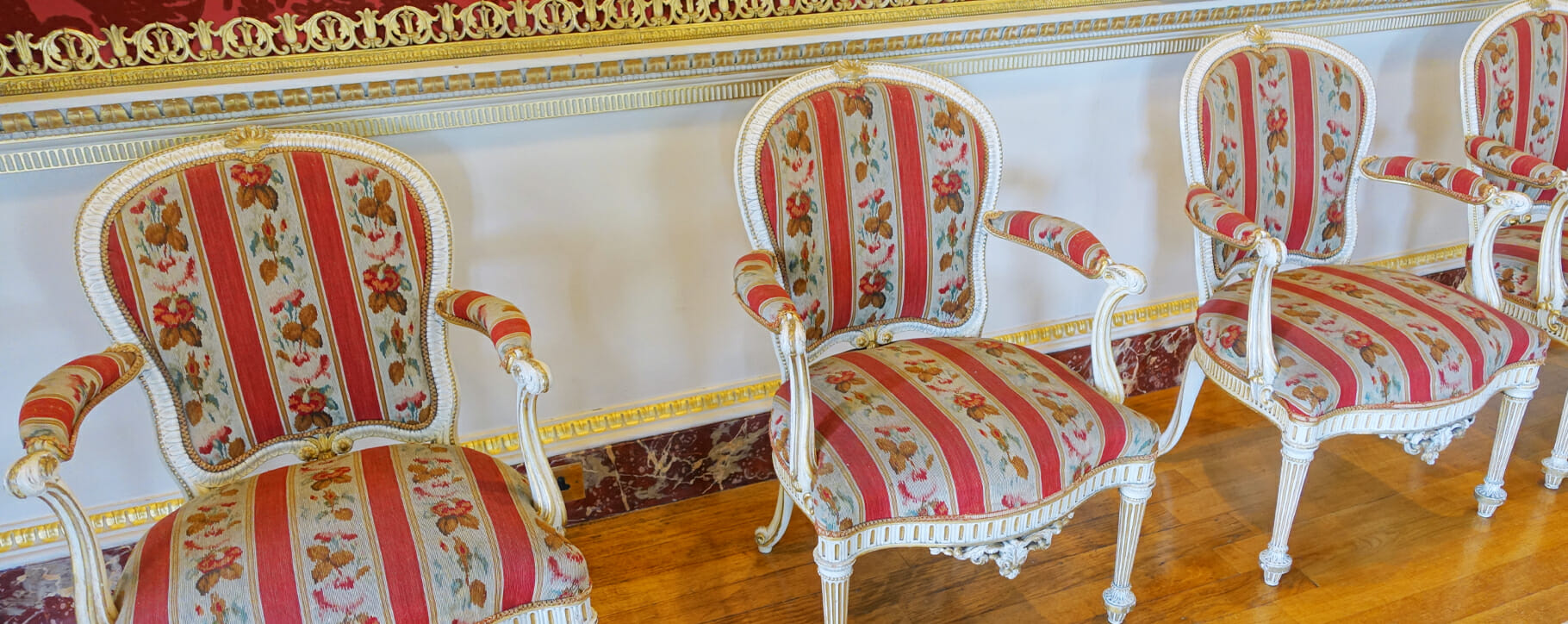 Above: collections and sets of chairs can all be restored at the same time to ensure they are all well-preserved and protected to the same standard
Above: collections and sets of chairs can all be restored at the same time to ensure they are all well-preserved and protected to the same standard




